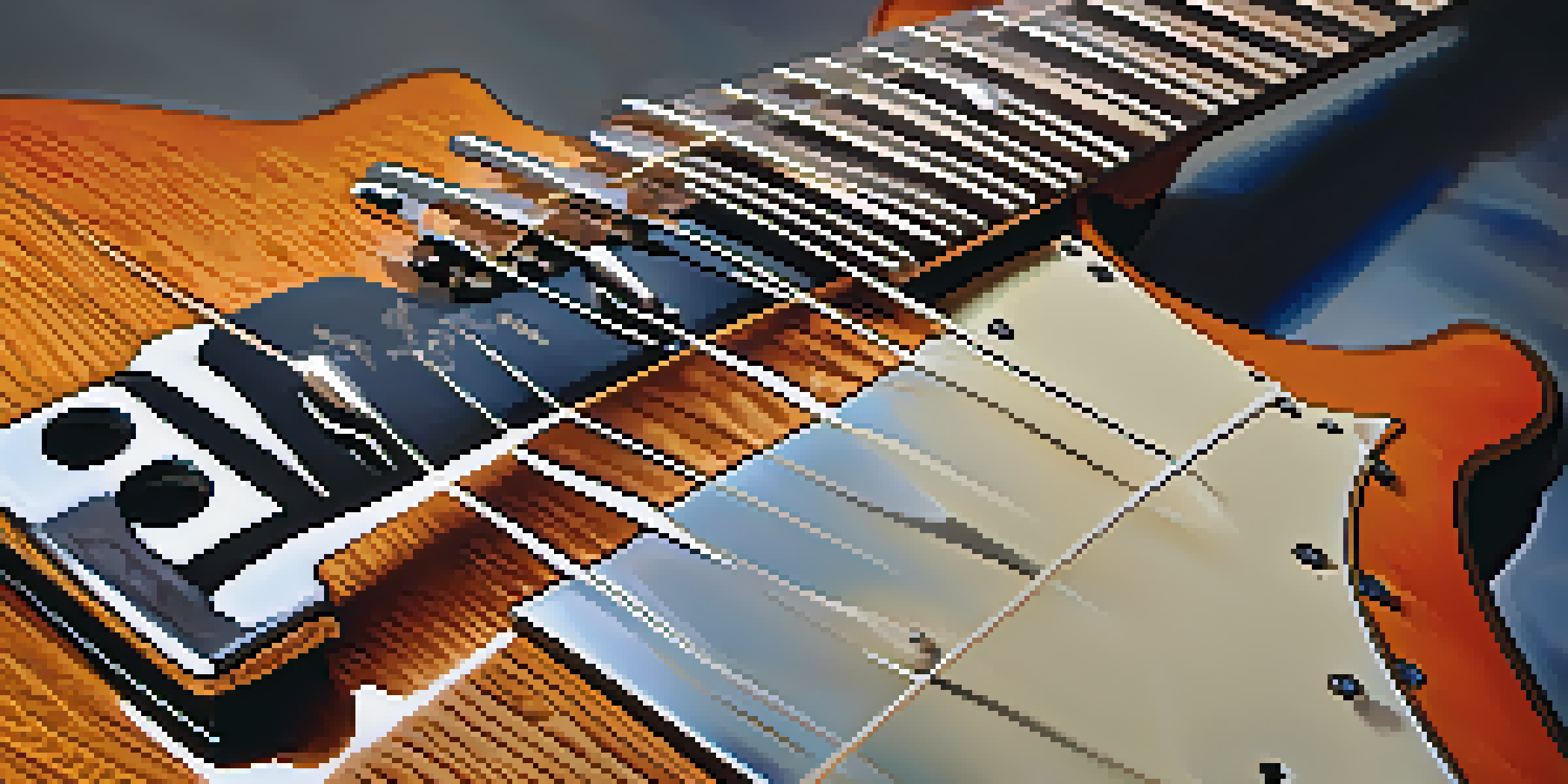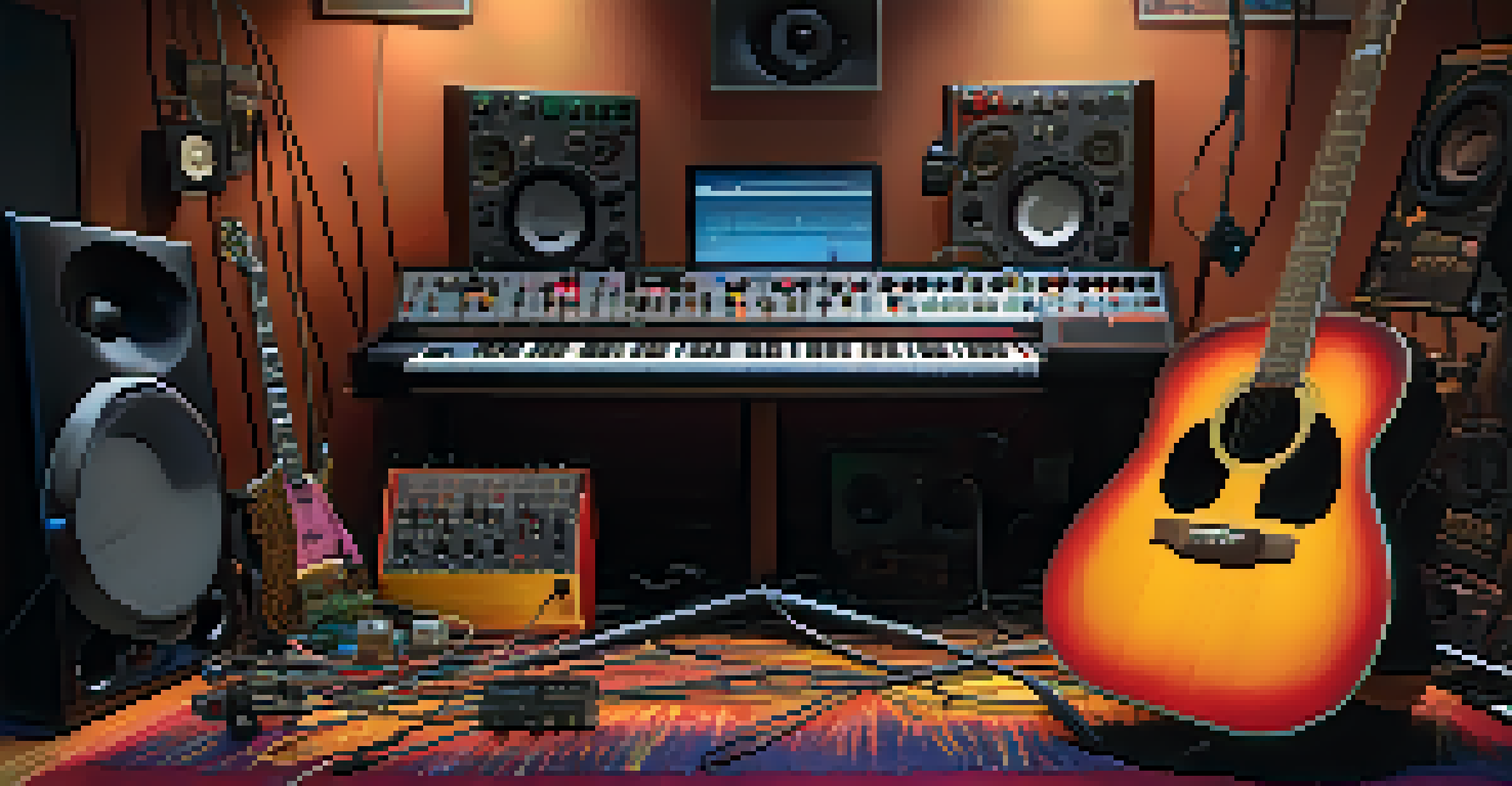Understanding Signal Flow in Guitar Recording and Mixing

What is Signal Flow and Why Does It Matter?
Signal flow refers to the path an audio signal takes from its source to the final output. Understanding this concept is crucial for anyone involved in recording and mixing, particularly guitarists. By mastering signal flow, you can make informed decisions that enhance the quality of your recordings and mixes.
The signal flow is the lifeblood of any audio production. Understanding it will transform your recordings from flat to phenomenal.
Imagine a river flowing through a landscape; just as the river’s course affects what it touches, the signal flow determines how your guitar sound is shaped. If you want to achieve a specific tone or effect, knowing where to place your devices in the signal chain is essential. This foundational knowledge helps you troubleshoot issues and optimize your setup.
In the world of music production, signal flow can make or break your track. Whether you're a seasoned pro or a beginner, grasping the basics of signal flow will empower you to create better recordings and mixes, ensuring your guitar shines in the final product.
The Basic Components of Signal Flow
At its core, signal flow involves several key components: the instrument, effects pedals, interface, and software. Each element plays a vital role in shaping your sound. For instance, your guitar's pickups capture the vibrations and send them through the cable to your effects pedals, which modify the signal before it reaches your recording interface.

Think of each component as a link in a chain; if one link is weak or missing, the entire signal flow can be compromised. Understanding how these components interact will help you identify potential bottlenecks or areas for improvement in your setup. The more familiar you become with each piece, the more control you have over your sound.
Understanding Signal Flow
Mastering signal flow is essential for enhancing the quality of your recordings and mixes.
Additionally, learning how to connect these components correctly ensures optimal sound quality. For instance, placing distortion pedals before modulation effects can produce more vibrant sounds. This knowledge allows you to experiment and find the perfect setup for your musical style.
Signal Flow in the Recording Process
When recording guitar, the signal flow starts with your instrument and ends at your digital audio workstation (DAW). It’s essential to ensure that every step of this journey is optimized to capture the best sound possible. This might involve adjusting the gain on your interface or using the right microphone for an amp.
Every effect has its place in the chain, and knowing where to position them can make all the difference in achieving your desired sound.
As you record, the signal travels through various stages, including effects processing and mixing. Each stage has the potential to enhance or degrade your sound, making it vital to pay attention to how your signal flows through your entire setup. For example, if you're using a mic to capture an amp, positioning and mic choice can significantly impact your final sound.
Moreover, understanding signal flow during recording helps you anticipate any issues that may arise. For instance, if you're experiencing unwanted noise or distortion, knowing where the problem might lie in your signal path allows you to troubleshoot effectively.
Effects and Their Role in Signal Flow
Effects pedals can significantly alter the character of your guitar sound, which is why their placement in the signal flow is so important. For example, placing a compressor before a distortion pedal can smooth out your dynamics, leading to a more consistent tone. Understanding how each effect interacts with your guitar signal is key to achieving the desired sound.
Visualize your signal flow as a recipe; just as the order of ingredients affects the final dish, the order of effects can drastically change your tone. By experimenting with different placements, you can discover unique sounds that add depth and richness to your recordings. Don't be afraid to try unconventional setups; you might stumble upon your new favorite tone.
Impact of Effects Placement
The order of effects in your signal chain can dramatically alter your guitar tone.
Additionally, keep in mind that different effects can react differently depending on their position in the chain. For instance, delay pedals can sound more pronounced when placed after overdrive. By understanding these nuances, you can harness the full potential of your effects and create a signature sound.
Connecting Your Gear: Cables and Interfaces
The quality of your cables and interfaces can significantly influence your signal flow. High-quality cables ensure that your signal travels without interference, preserving the integrity of your sound. On the other hand, using subpar cables can lead to unwanted noise and signal loss, affecting the overall quality of your recordings.
When it comes to interfaces, they act as the bridge between your guitar and your computer. Choosing the right interface with adequate inputs and outputs is essential for a smooth recording process. Consider factors such as latency, sample rate, and audio resolution when selecting your gear to ensure optimal performance.
Moreover, proper cable management is crucial for maintaining a clean signal flow. Tangle-free cables can prevent accidental disconnections and make it easier to troubleshoot any issues that may arise during recording or mixing.
Mixing: How Signal Flow Affects Your Sound
Once you've recorded your guitar tracks, the next step is mixing, where signal flow continues to play a vital role. During mixing, each track's signal flow determines how it interacts with other elements in the mix. Understanding how to route your guitar tracks effectively can lead to a more balanced and polished final product.
For instance, you might want to send your guitar track to an auxiliary channel for adding reverb or delay. By adjusting the levels and effects applied in this stage, you can create a more immersive listening experience. Think of mixing like painting; each element needs to be placed thoughtfully to create a cohesive masterpiece.
Troubleshooting Signal Issues
Identifying and resolving signal flow problems can save time and improve your recording quality.
Additionally, monitoring your signal flow during mixing helps you make informed decisions about levels and effects. Knowing where each sound is coming from allows you to adjust accordingly, ensuring that your guitar cuts through the mix without overpowering other instruments.
Troubleshooting Common Signal Flow Issues
Even experienced musicians encounter signal flow issues from time to time. Common problems include unwanted noise, distortion, or a lack of clarity in your recordings. By learning how to troubleshoot these issues, you can save time and frustration during your recording sessions.
Start by checking each component in your signal chain. Ensure all cables are securely connected and in good condition, and make sure your interface settings are correct. If you notice unwanted noise, it could be an issue with grounding or interference from other electronic devices.

Additionally, experiment with different placements of your effects pedals and other gear. Sometimes, simply rearranging your signal flow can resolve issues and lead to a more desirable sound. Remember, every setup is unique, so don’t hesitate to think outside the box when troubleshooting.